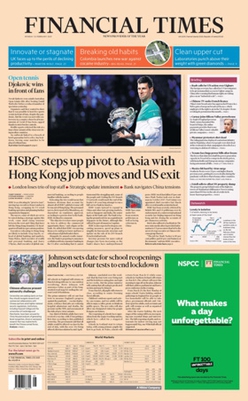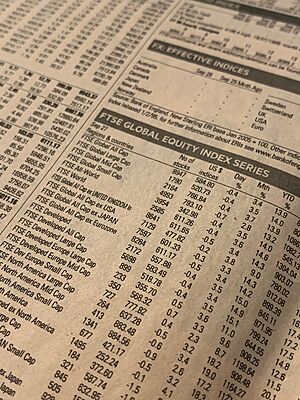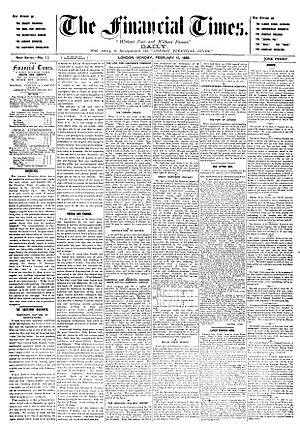Financial Times facts for kids

Cover of the 22 February 2021 issue
|
|
| Type | Daily newspaper |
|---|---|
| Format |
|
| Owner(s) | The Financial Times Ltd. (Nikkei Inc.) |
| Founder(s) | James Sheridan |
| Founded | 9 January 1888 |
| Political alignment | Liberalism Conservative liberalism Centre to centre-right |
| Language | English |
| Headquarters | Bracken House London, England |
| Circulation | 106,871 (as of February 2025) |
| Sister newspapers | Nikkei Asia |
| ISSN | 0307-1766 |
| OCLC number | 60638918 |
The Financial Times (often called the FT) is a British daily newspaper. It focuses mainly on business and economic news. It's printed on a special light-pink (or salmon) paper and is also available online.
The FT is based in London, England. It is owned by a Japanese company called Nikkei. The newspaper has main offices in Britain, the United States, and Europe. In 2015, Nikkei bought the FT from a company called Pearson for about £844 million (which is about $1.32 billion).
The FT is known for its deep focus on financial news and economic analysis. It doesn't usually cover general news like other newspapers. In 2023, it had 1.3 million subscribers, and most of them read it digitally. The FT also gives out an annual book award and names a "Person of the Year."
Contents
History of the Financial Times
How the FT Started
The Financial Times first launched on January 10, 1888. It was originally called the London Financial Guide. A month later, on February 13, 1888, it changed its name to the Financial Times.
It was a four-page newspaper for people in the financial world of London. Its main competitor was the Financial News, which started in 1884. To stand out, the FT began printing on light pink paper in 1893. This pink color came from a type of clay used to make the paper. At the time, it was cheaper not to bleach the paper white. Today, the pink paper is a special and more expensive choice.
Becoming a Bigger Newspaper
In 1945, the Financial Times merged with its old rival, the Financial News. This merger helped the FT become one of the largest business newspapers in the world.
Over the years, the FT grew a lot. It started having reporters in cities all over the world. This happened as global trade and money flow increased. In 1979, the first FT newspaper was printed outside the UK, in Frankfurt, Germany. Printing in the US began in 1985.
Now, the FT is a global newspaper. It's printed in 22 different places and has five international editions. These editions serve readers in the UK, Europe, the US, Asia, and the Middle East.
The FT Online
The Financial Times first went online on May 13, 1995, with FT.com. At first, it offered news summaries and stock prices. In 2002, the FT started asking people to pay for some of its online content. FT.com is one of the few news websites in the UK that successfully gets people to pay for subscriptions.
In 2007, the FT started using a "metered paywall." This meant visitors could read a few free articles each month before needing to subscribe. In 2011, they launched a mobile app for phones and tablets. By 2012, more people were subscribing to the digital version than buying the printed newspaper. Also, almost half of the FT's money came from subscriptions, not just advertising.
In 2015, the FT changed its paywall. Visitors could get unlimited free access for one month before needing to subscribe.
Recent Events
In 2019, the FT began a series of investigative articles about a German payments company called Wirecard. The FT reporters looked into suspicions of fraud at the company. In June 2020, Wirecard announced that €1.9 billion of its reported cash might not exist. The company later went out of business.
The FT also launched a new app in 2022 called FT Edit. This app is designed to be lower-priced and attract younger readers.
What the FT Covers
The FT newspaper is usually split into two main parts. The first part covers news from the UK and around the world. It also includes opinion pieces from FT journalists and other important leaders and thinkers.
The second part has financial information and news about companies and markets. Even though it's mostly a financial newspaper, it also includes things like TV listings, weather, and other lighter articles. Recently, the FT has started focusing more on the cryptocurrency industry. It has launched new tools and newsletters about digital money. About 110 of its 475 journalists work outside the United Kingdom.
The Lex Column
The Lex column is a special daily feature found on the back page of the first section. It offers analysis and opinions on global economics and finance. The FT calls Lex its "agenda-setting" column, meaning it often sets the topics people talk about. It first appeared in 1945. Many famous people who later had important jobs in business and government used to write for Lex.
FT Weekend
The FT publishes a special Saturday edition called the Financial Times Weekend. This edition includes international economic and political news, company and market updates, and sections on "Life & Arts" and "House & Home." It also includes the FT Magazine.
HTSI Magazine
HTSI (which used to be called How to Spend It) is a weekly magazine that comes with FT Weekend. It features articles about luxury items like yachts, mansions, fancy cars, and high fashion. It also has columns about arts, gardening, food, and travel. The magazine started in 1967 as a small feature in the newspaper. Its name was changed to HTSI in 2022.
What the FT Believes In
The Financial Times supports free markets and globalization. This means it believes in open trade between countries and less government control over businesses. In the 1980s, it supported the economic policies of leaders like Margaret Thatcher and Ronald Reagan.
The FT's opinion pieces tend to be pro-European. It was strongly against the Iraq War. Because it supports free markets and free trade, the FT is often seen as a newspaper with political views that are in the middle or slightly to the right.
UK Politics
The FT has supported different political parties in UK elections over the years. For example, it supported the Labour Party in 1992 but then backed the Conservative Party in 2010 and 2015. In the 2019 election, the FT did not officially support any party. For the 2024 election, the FT endorsed the Labour Party, saying the country needed a "fresh start."
US Politics
In US presidential elections, the Financial Times has often supported Democratic candidates. It endorsed Barack Obama in 2008 and 2012. It also supported Hillary Clinton in 2016, Joe Biden in 2020, and Kamala Harris in 2024.
Ownership and Other Publications
Since 2015, the FT has been owned by Nikkei, Inc., a Japanese company. The FT group also has other publications and services. For example, it has a unit called FT Specialist, which provides information on finance. This includes magazines like The Banker and Money Management.
The Financial Times also has an educational company called FT Knowledge. This company offers courses and events about the financial world.
Financial Indexes

The Financial Times collects and publishes several financial market indexes. These indexes show how the value of different parts of the stock market changes. One of the most famous is the FTSE 100. The letters F-T-S-E stand for Financial Times (FT) and the London Stock Exchange (SE), because it was a joint project between them. The FTSE 100 was created in 1984 and represents about 80% of the value of the London Stock Exchange.
Other well-known FTSE indexes include the FTSE All-Share Index and the FTSE 350 Index. In 2021, the Financial Times also started publishing indexes that track the top five cryptocurrencies.
People Behind the FT
Many journalists who worked at the FT have gone on to have important jobs in journalism, politics, and business. For example, Robert Thomson, a former US managing editor for the paper, later became the chief executive of News Corporation. Andrew Adonis, who was an education reporter, became an adviser to the British Prime Minister.
Sir Geoffrey Owen was the editor of the Financial Times from 1981 to 1990. He helped the newspaper adapt to new technologies during his time as editor.
Editors of the Financial Times
- 1889: Douglas MacRae
- 1890: William Ramage Lawson
- 1892: Sydney Murray
- 1896: A. E. Murray
- 1909: C. H. Palmer
- 1924: D. S. T. Hunter
- 1937: Archibald Chisholm
- 1940: Albert George Cole
- 1945: Hargreaves Parkinson
- 1949: Sir Gordon Newton
- 1973: Fredy Fisher
- 1981: Sir Geoffrey Owen
- 1991: Richard Lambert
- 2001: Andrew Gowers
- 2006: Lionel Barber
- 2020: Roula Khalaf
See also
 In Spanish: Financial Times para niños
In Spanish: Financial Times para niños
- Business journalism
- Financial Times Business Book of the Year Award
- Financial Times Person of the Year
- List of newspapers in the United Kingdom


